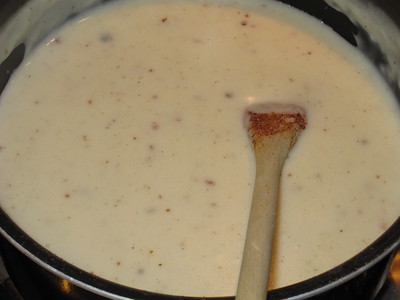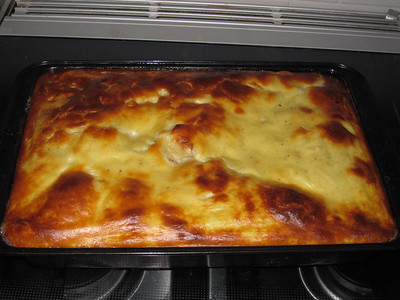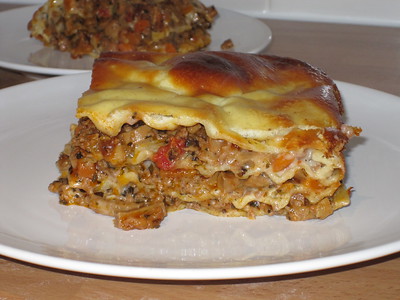A few weeks back, I started googling for ostrich meat. Our local butchers could only do steaks, but the internet revealed that there are more possibilities, one of them being a roast. And so I found a farm up in Lincolnshire called White House Farm. They do a variety of cuts and offer the possibility of paying via paypal which I found very appealing. On the day I placed my order, paypal had done something to their interface, which didn't accept my password and the lady at White House Farm very kindly called me and let me know that the purchase hadn't gone through. Not to mention that I had managed to generate two identical purchases. In fact, I ended up having to change the paypal password. Shame on you programmers and testers on not picking this one up!
But the next day my order went through. The ostrich was to be delivered on the 18th December. As many UK residents will know, it snowed on the 17th and I was worried that my order wouldn't be delivered, so I called them and again the very helpful lady I spoke with confirmed that my roast had gone out and should arrive on time. And it did, shortly after lunch, packed in a polystyrene box and taped to an ice pack. Very impressive. And I got a few tips on how to cook it too. It was pricey, though, £26 per kg. I bought their largest fillet roast which was 600 g and went for £15.60, but I think Christmas is only once a year and it's a festive occasion which is worth spending some extra money to make extra special. The fillet steak looked so tiny, once I put it in the fridge though.
The recipe I'd chosen was the simplest possible - the fillet roast coated in a mixture of spices and I found it on recipezaar. I also made the suggested sauce, which sadly was missing the unit for the amount of water, so I made a guess it should have been a cup. To be on the safe side, I'm writing both up below.
To accompany this special piece of meat, I chose potatoes, Savoy cabbage and mushrooms.
Roast Ingredients
2 tsp coriander seeds
2 tsp black pepper corns
2 tsp juniper berries
1 tsp cardamom seeds
3 cloves garlic
600 g ostrich fillet roast
3 tbsp grapeseed oil
Roast Method
- The spice seeds need to be ground. Recipezaar recommended mortar and pestle or blender. I decided to try the mortar and pestle and 30 minutes of work resulted in rather tired hands and squashed juniper berries, but nothing further. I transferred the mixture to my blender, which after about 5 minutes on high speed reached "cracked" stage, but I thought it should be finer still, so I ended up putting the whole lot through my coffee grinder (also manual!). I recommend doing this on the day before, while watching TV.
- Pre-heat the oven to 200 degrees C (gas mark 5).
- About 2 h before roasting, pat the fillet roast dry, then rub in the spice mixture along with the pressed garlic. After rubbing, I placed it in a bag, tied securely and rubbed it several times during the 2 h of standing.
- When the 2 h are up, heat up the grapeseed oil and brown the ostrich roast on all sides. Be careful as this is extremely lean meat, about 30 - 45 seconds on each side on medium high is enough. Then transfer to an oven safe dish.
- Bake in the middle of the oven for 15 minutes, then take out and check the middle by cutting into it. If it seems too pink, give it another 5 minutes, the check again. For me it seemed still a bit too red, so I gave it another 15 minutes at gas mark 3 which corresponded to 150 degrees. It seems that ostrich meat can be eaten rare to medium rare, like beef. I went for medium rare and after it had baked, I let it rest for some 10 minutes. The roasting will vary with the size of the fillet - mine was long and fairly thin, but if it's thicker, it might need longer. Thus keep checking by cutting into it.
Cream Mushrooms Ingredients
250 g fresh chestnut mushrooms
salt to taste
1 tbsp butter
1 dl double cream
Cream Mushrooms Method
- Peel the mushrooms and cut off the edge of the stem if it looks dry, but keep intact for visual impact.
- After browning the ostrich meat, add a bit more grapeseed oil to it if needed, then fry the whole mushrooms for a few minutes, stirring so they pick up the flavours from the meat. Add the salt to help release the juices.
- Transfer to the oven safe dish with the ostrich and bake together. I recommend making sure the mushrooms are placed so that they stand on their stems, that way whatever juices they release, it'll run to the bottom of the dish, rather than stay contained in the mushroom cups.
- When the meat is ready and out of the oven. Heat up the butter in a frying pan on medium heat, then add the mushrooms and the cream and stir around for a few minutes so they take up the flavour. Transfer to a serving dish and keep warm until serving, if needed.
Gravy Ingredients
2.5 dl red Merlot wine
0.5 dl port wine
3 tbsp cranberry sauce
1.25 dl water
2 Oxo beef cubes
2 tbsp fine balsamic vinegar
the liquid from the ostrich roast and the mushrooms.
1 tbsp butter
1 tbsp Bisto beef gravy granules
Gravy Method
- Put together all ingredients except the juices from the meat/mushrooms, butter and gravy granules, into a sauce pan and bring to the boil, stirring occasionally. Reduce to about half the original size, then set aside until the meat is ready.
- When the ostrich and mushrooms have baked, pour the liquid into the gravy sauce pan and just before serving, bring it to the boil, then add the butter.
- Once the butter has melted, add the gravy granules and continue to simmer for a few more minutes until they have dissolved.
Spicy Savoy Cabbage and Peas Ingredients
350 g Savoy cabbage
3 tbsp grapeseed oil
3 tbsp finely grated fresh ginger
1 tsp hot chilli powder
1 tsp turmeric
2 dl frozen peas
2 tbsp water if needed
Spicy Savoy Cabbage and Peas Method
- Shred the Savoy cabbage.
- Heat up the grapeseed oil in a deep-ish saucepan on medium and add the cabbage, stirring vigorously to prevent it from burning.
- Add the ginger, chilli and turmeric and keep stirring to get it well blended.
- After frying for a few minutes, add the peas and fry for 3 - 4 minutes more. If it seems too dry, add water and keep stirring.
- Transfer to a serving dish and keep warm until serving.
The potatoes are my usual Hasselback style, but with goose fat, instead of grapeseed oil. Using a different oil didn't result in a big difference, like when doing regular roast potatoes, oddly enough. I only buy goose fat for the Christmas roast potatoes, so didn't want to drop this tradition.
Et voilà, le tout ensemble:
As a starter we had Veuve Clicquot But with a wild hibiscus flower to accompany our salad made of 500 g grated carrots, 500 g grated mooli and 1 dl sesame seeds. There was quite a bit left over. This is a fairly traditional Bulgarian Winter salad, no extremes in flavour, just juicy and crunchy. We dressed it with rice vinegar and toasted sesame oil, both of which were a bit overpowering, so will probably skip them next time.
For dessert, I went for the lovely Margarita ice cream from Nigella Lawson. We had this a couple of weeks ago at our friends' Stephen and Kerry of Dinnerdiary. I don't really like Nigella, not sure why exactly and catching glimpses of her Nigella Express show, put me off food for some time, but this recipe is really good and very easy.
I made an alteration of course, I added 150 g dessicated coconut and it worked a treat! For serving I used chocolate cups and I dusted the plate with coconut flavoured cocoa powder from Whittard of Chelsea. Regular drinking chocolate cocoa powder.
Round up:
It was wonderful. All of it, Possibly best Christmas dinner since we started these in 2002.
Lundulph concurs by saying "It was right tasty!".
Of course, spending about an hour before lunch watching the birds in our back garden helped - it had snowed overnight again, but it was sunny and we counted 27 different birds! The special treat being the bullfinches and blackcaps - both males and females!
In particular the ostrich was great - no gritty bits, just pure muscle meat and I was lucky to get it just right. The texture was great, the pepperiness of the spices combined perfectly with the sweetness of the gravy and the heat of the cabbage meant the whole meal felt hot throughout. This is a thing with Lundulph, he likes his food piping hot and sadly even pre-warming our plates doesn't make much difference, they cool down pretty quickly. The chilli powder provided the spicy heat to give the impression of temperature heat. Brilliant!
It was hard to resist having seconds, but I managed just. After all there was dessert coming.
I'm definitely going to cook ostrich again, it may well be the perfect meat for me. I've always been fussy when it comes to meat and generally I need to see the meat in order to decide if I'll eat it or not and grisly and crunchy bits are a big no. I can't even force them down. But the ostrich fillet roast was completely free from these.




